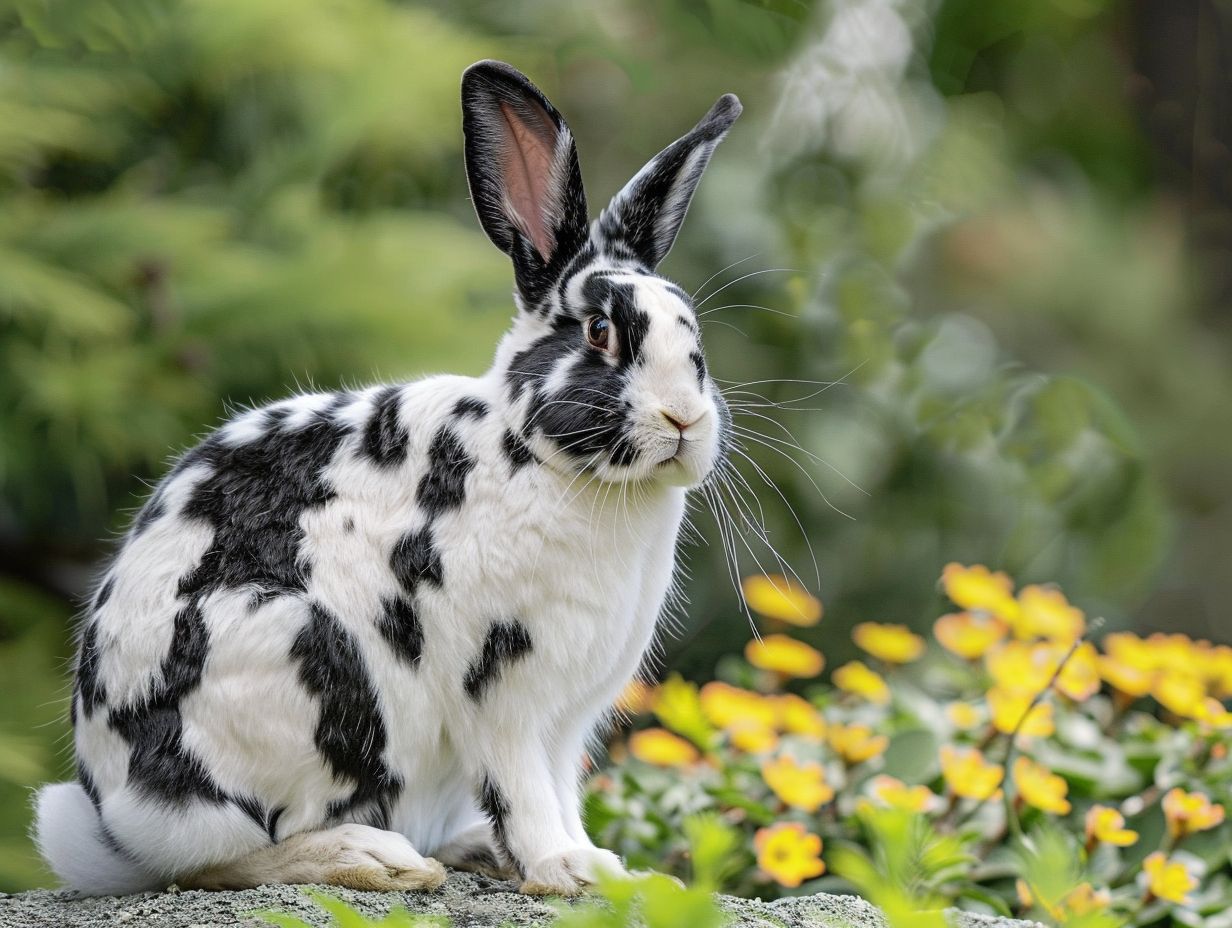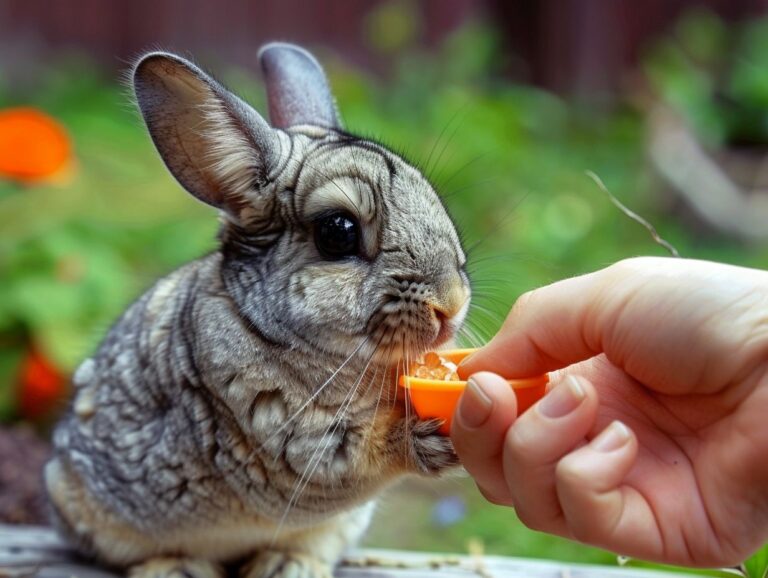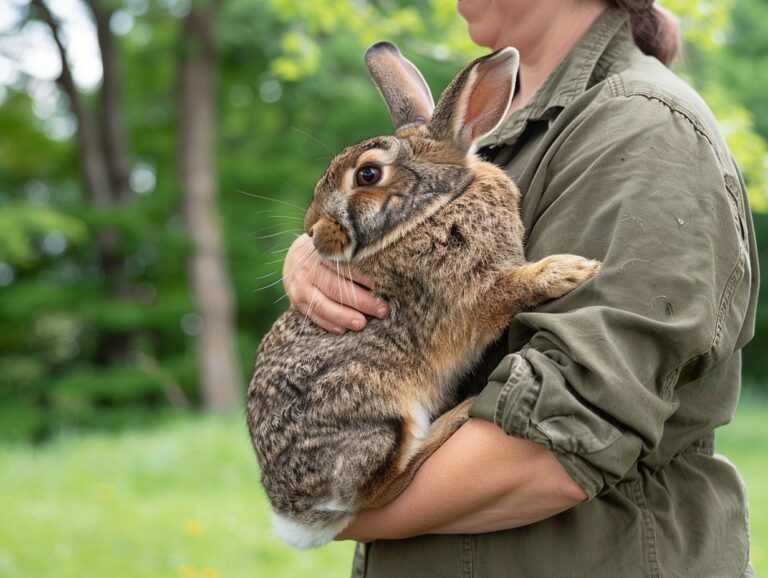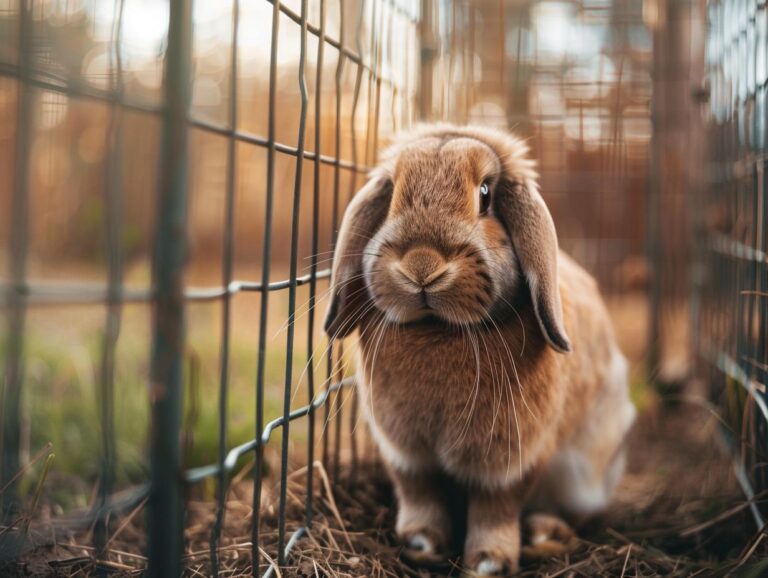Checkered Giant Rabbits As Pets: Care, Diet, and Health For Giant Sized Breeds
Are you considering adding a Checkered Giant Rabbit to your family? These larger-than-life rabbits are not only adorable but also make great pets.
In this article, we will explore everything you need to know about Checkered Giant Rabbits, including their size, characteristics, basic needs, common health issues, and how to care for them.
From their color patterns to their ideal diet and grooming routine, we’ve got you covered. Let’s dive into the world of these gentle giants and learn how to provide them with the best possible care.
Key Takeaways:
What Are Checkered Giant Rabbits?
Checkered Giant Rabbits are a specific breed of giant rabbits known for their distinctive markings and large size compared to other breeds. They are part of the diverse range of rabbit breeds, each with unique characteristics and appearances.
Originating in France in the early 1900s, Checkered Giants were developed through crosses between Flemish Giants and various spotted breeds. Their distinct coloring, featuring bold checkered patterns, sets them apart from other rabbits. These rabbits have a striking appearance with their large bodies and erect ears. Unlike some breeds known for docile temperaments, Checkered Giants are energetic and curious, often showcasing playful behaviors. Their friendly nature makes them popular as pets and show animals, attracting breeders and enthusiasts alike.
How Big Do Checkered Giant Rabbits Get?
Checkered Giant Rabbits can grow to impressive sizes, often reaching weights that categorize them as true giant rabbits. Their size distinguishes them from smaller rabbit breeds, making them a popular choice for those seeking large and impressive pets.
The average weight of a Creme Dargent Rabbit ranges from 10 to 12 pounds, with some individuals even exceeding this range. In comparison to other rabbit breeds, such as the Netherland Dwarf or Polish Dwarf, which typically weigh around 2-3 pounds, Creme Dargent Rabbits truly live up to their name. Learn more about care, diet, and health for large sized breeds.
Despite their large size, Checkered Giants are known for being graceful and agile, moving with surprising speed and agility for their bulk. Their impressive size is not just limited to weight, as they also boast elongated bodies and strong, muscular limbs that contribute to their majestic appearance.
What Are the Average Sizes of Other Giant Rabbit Breeds?
Various giant rabbit breeds exhibit different average sizes, with breeds like Flemish Giants and Continental Giants often surpassing standard rabbit sizes by a significant margin. These breeds are known for their impressive stature and are favored by many rabbit enthusiasts seeking large companions.
For instance, Flemish Giants are one of the largest giant rabbit breeds, usually weighing between 13 to 22 pounds and measuring around 2.5 feet long. In comparison, Continental Giants can weigh even more, with an average weight ranging from 16 to 25 pounds and a length reaching up to 3 feet.
Other large giant rabbit breeds include the French Lop, which typically weighs around 10 to 15 pounds and has long floppy ears, giving it a distinctive appearance among the giant rabbit varieties.
What Are the Characteristics of Checkered Giant Rabbits?
Checkered Giant Rabbits are known for more than just their size; they possess distinct temperaments, grooming requirements, and lifespans that set them apart from other rabbit breeds. Understanding these characteristics is essential for proper care and maintenance.
Regarding their temperament, Checkered Giant Rabbits are often described as friendly, curious, and social animals. They enjoy human interaction and can form strong bonds with their owners. This makes them an excellent choice for individuals looking for a companion pet that thrives on attention and affection.
- Grooming needs for Checkered Giant Rabbits are relatively low maintenance compared to some other long-haired breeds. Regular brushing to prevent matting and occasional nail trimmings are typically all that’s needed to keep their coats in good condition.
- In terms of lifespan, Checkered Giant Rabbits have an average life expectancy of 5 to 7 years when properly cared for. This lifespan is relatively longer than some other rabbit breeds, making them a long-term commitment for prospective owners.
What Are the Color Patterns of Checkered Giant Rabbits?

One common color pattern found in Checkered Giants is the broken pattern, where the base color is combined with white patches scattered throughout the body. Some rabbits exhibit the butterfly pattern, characterized by a solid-colored nose with markings extending out to the ears.
Color variations include black, blue, chocolate, and more, offering a wide range of choices for rabbit enthusiasts.
What Is the Temperament of Checkered Giant Rabbits?
The temperament of Checkered Giant Rabbits is generally known to be docile and friendly, making them suitable as pets for individuals seeking a gentle and sociable rabbit companion. Understanding their temperament can help create a harmonious environment for these rabbits.
Checkered Giant Rabbits typically exhibit a calm demeanor, which contributes to their reputation as delightful pets. Their friendly nature extends to their interactions with both humans and other animals, fostering a harmonious household environment.
These rabbits are sociable creatures, enjoying human companionship and often seeking out affection and attention from their owners. Their gentle temperament also makes them well-suited for families with children, as they are patient and tolerant. Providing them with ample social interaction and mental stimulation can further enhance their well-being and overall happiness.
What Are the Basic Needs of Checkered Giant Rabbits?
Meeting the basic needs of Checkered Giant Rabbits is crucial for their overall well-being. Providing proper housing, a balanced diet, and sufficient exercise are essential components in ensuring the health and happiness of these large rabbit breeds.
Regarding housing, Checkered Giants require spacious accommodations that allow them to move around freely. A large rabbit hutch or cage with plenty of room to stretch and hop is ideal. It’s important to ensure the enclosure is secure, well-ventilated, and protected from extreme temperatures.
As for their diet, Checkered Giants thrive on a variety of fresh Beveren rabbits diet hay, vegetables, and high-quality pellets. Hay should make up the majority of their diet, as it aids in digestion and keeps their teeth healthy.
In terms of exercise, these energetic rabbits need ample space to run and play. Providing daily opportunities for them to explore and exercise outside of their cage is vital for their physical and mental well-being.
What Kind of Housing Do Checkered Giant Rabbits Need?
Checkered Giant Rabbits require spacious and secure housing to accommodate their large size and active nature. Providing ample space for movement and proper ventilation is essential to ensure the well-being of these magnificent rabbits.
When setting up housing for Checkered Giant Rabbits, it’s crucial to have enclosures that are at least four times the size of the rabbit to allow for hopping and stretching. The flooring should be solid to prevent injuries to their delicate feet. Since these rabbits are prone to overheating, ventilation is a top priority to maintain optimal temperature levels.
Considering their curious nature, ensuring a secure enclosure is vital to prevent escape attempts, as these rabbits are known for their agility. Providing hiding spots and tunnels within their housing can also stimulate their natural instincts and enrich their environment.
What Is the Ideal Diet for Checkered Giant Rabbits?
The ideal diet for Checkered Giant Rabbits should consist of high-quality hay, fresh vegetables, and a balanced rabbit pellet mix. Providing the right nutrition is key to supporting their growth and overall health.
Hay is an essential component of a Checkered Giant Rabbit’s diet as it helps maintain proper dental health and digestive function.
Fresh vegetables provide essential vitamins and minerals, contributing to a well-rounded nutrition plan. It’s crucial to offer a variety of veggies like dark leafy greens, carrots, and bell peppers. A high-quality rabbit pellet mix ensures they receive necessary proteins and nutrients. By incorporating these foods into their diet, you can help your Checkered Giant Rabbit lead a healthy and happy life.
What Kind of Exercise Do Checkered Giant Rabbits Need?

Checkered Giant Rabbits benefit from regular exercise to maintain their physical health and prevent obesity. Providing opportunities for movement, play, and exploration is essential for keeping these large rabbits active and happy.
Creating a stimulating environment with tunnels, ramps, and climbing structures can encourage the New Zealand rabbits to stay physically engaged and mentally stimulated. Incorporating a variety of toys such as cardboard boxes, chew toys, and puzzle feeders can also help satisfy their natural curiosity and instinct to forage.
Interacting with your Checkered Giant rabbits during playtime can strengthen the bond between you and provide them with much-needed social interaction. It’s important to monitor their activity levels and adjust the exercise routine accordingly to ensure they are getting adequate physical activity.
What Are the Common Health Issues of Checkered Giant Rabbits?
Checkered Giant Rabbits are prone to specific health issues such as pododermatitis, arthritis, and other conditions that can affect their well-being. Recognizing and addressing these common health concerns is vital for ensuring the longevity of these large rabbit breeds.
Pododermatitis, commonly known as sore hocks, is a prevalent issue in silver fox rabbits as pets and other large rabbits. This condition results from the prolonged pressure on the feet, leading to inflammation and sometimes infection.
Arthritis, another common ailment, can cause stiffness and pain in the joints, affecting their mobility. Satin rabbits as pets can have dental problems due to their continuously growing teeth, requiring proper monitoring and care to prevent complications.
It’s crucial for owners to provide a well-balanced diet, regular exercise, and proper hygiene practices to mitigate these health challenges.
What Are the Signs of Illness in Checkered Giant Rabbits?
Recognizing the signs of illness in Checkered Giant Rabbits is crucial for early intervention and treatment. Symptoms like lethargy, changes in appetite, or abnormalities in behavior should prompt immediate veterinary attention to ensure the well-being of these large rabbits.
Some health issues that may arise in Checkered Giant Rabbits include respiratory problems, gastrointestinal disturbances, dental issues, and musculoskeletal conditions. Monitoring their physical condition daily is essential to catch any signs of illness early on.
Other signs of illness to look out for in Checkered Giant rabbits are excessive grooming or fur loss, discharge from the eyes or nose, and a hunched posture. Any sudden changes in behavior or routine warrant a visit to a vet.
How Can You Prevent Health Issues in Checkered Giant Rabbits?
Preventing health issues in Checkered Giant Rabbits involves proactive measures such as regular veterinary check-ups, maintaining proper hygiene, and preventing conditions like flystrike. Implementing preventive strategies can significantly enhance the well-being of these large and sensitive rabbits.
Regularly checking your Checkered Giant Rabbit with a qualified veterinarian is crucial in identifying any health concerns early on. Vaccinations, dental care, and parasite prevention should be part of the routine veterinary visits. While handling your rabbit, ensure that you wash your hands before and after to prevent the spread of diseases. Keep their living area clean and dry to minimize the risk of infections.
Another common health issue in Checkered Giants is obesity, so monitor their diet closely and provide ample opportunities for exercise. Protect them from flystrike by keeping their fur clean and dry, especially during warmer months when flies are more prevalent.
How to Care for Checkered Giant Rabbits?
Caring for Checkered Giant Rabbits involves a holistic approach that encompasses grooming, nutrition, health monitoring, and environmental considerations. Providing attentive care tailored to the specific needs of these large rabbits is essential for their overall well-being.
Regarding grooming, regular brushing to prevent matting of their dense fur is crucial, especially during molting seasons. Additionally, Checkered Giant Rabbits need to have their nails trimmed regularly and their ears checked for cleanliness to avoid infections. In terms of nutrition, a diet rich in high-quality hay, fresh vegetables, and a controlled amount of pellets is recommended for optimal health.
What Is the Grooming Routine for Checkered Giant Rabbits?

Checkered Giant Rabbits require meticulous care to avoid common skin problems, such as pododermatitis, which can lead to painful sores on their sensitive hocks. These rabbits have dense fur that needs to be brushed at least once a week to prevent matting and minimize shedding. Regular nail trims are crucial to prevent overgrowth that can affect their gait and overall health. Along with the physical grooming routine, it’s important to monitor their diet to ensure they are receiving proper nutrition for healthy skin and coat.
Frequently Asked Questions
What are Checkered Giant Rabbits and why are they suitable as pets?
Checkered Giant Rabbits are a giant sized breed of rabbits, usually weighing 11 pounds or more. They are known for their unique checkered pattern on their fur and make great pets due to their docile and friendly nature.
What is the ideal diet for a Checkered Giant Rabbit?
A balanced diet for a Checkered Giant Rabbit includes unlimited hay, fresh vegetables, and a limited amount of high-quality pellets. It is important to monitor their food intake and avoid giving them sugary or fatty treats.
How much exercise do Checkered Giant Rabbits need?
Checkered Giant Rabbits are very active and require at least 3-4 hours of exercise daily. This can include supervised outdoor playtime or indoor space to run and hop around. Providing them with toys and tunnels can help keep them entertained and active.
Can Checkered Giant Rabbits live indoors?
Yes, Checkered Giant Rabbits can live indoors as long as they have enough space to move around and exercise. It is important to bunny-proof the area and provide them with a litter box to help keep their living space clean.
What are some common health issues to look out for in Checkered Giant Rabbits?
Checkered Giant Rabbits are generally healthy animals, but they are prone to certain health issues such as dental problems, obesity, and gastrointestinal stasis. It is important to regularly check their teeth, monitor their weight, and watch for any changes in their eating or bathroom habits.
How can I ensure the overall well-being of my Checkered Giant Rabbit?
To ensure the overall health and well-being of your Checkered Giant Rabbit, it is important to provide them with a proper diet, plenty of exercise, and regular check-ups with a rabbit-savvy veterinarian. It is also crucial to give them plenty of love, attention, and a safe, comfortable living environment.




